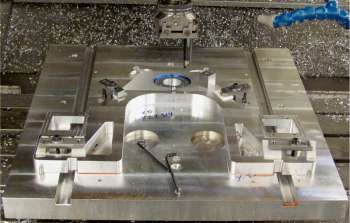sci10013 — Announcement
Mosaic Upgraded and New Spectrographs to Arrive
November 30, 2010
In 2009, the NSF awarded NOAO $3M to address the high priority initiatives recommended by the Renewing Small Telescopes for Astronomical Research (ReSTAR) committee, as described in the August 2009 issue of Currents. These initiatives are aimed at modernizing the capabilities on telescopes smaller than 6.5-m in aperture in the US System and increased access to these facilities.
In addition to providing access to the Palomar 200-inch telescope and its spectroscopic capabilities, the NSF funds were directed toward building a copy of the OSMOS spectrograph for the Mayall 4-m telescope on Kitt Peak, and upgrades to the optical detector and controller systems at CTIO and KPNO. Here, we report on the progress of these Phase 1 ReSTAR programs and announce the continuation of new programs in Phase 1 supported by additional supplemental funding from NSF in FY10.
Upgrade to Kitt Peak Mosaic 1.1
The Kitt Peak Mosaic 1 imager has been upgraded to provide users with substantially faster readout times and improved reliability. Science users at the Mayall 4-m telescope have been observing with the Mosaic 1.1 system since first light, which was achieved on the night of October 22-23. The system is performing as expected; readout times in particular have dropped from 150 seconds to 18 seconds. Further information is available at the Mosaic website.
These gains result from the installation of eight new e2v CCDs and NOAO Monsoon controllers. The upgrade took about one year to go from design to operation under the guidance of project manager and engineer, David Sawyer. Sawyer’s NOAO team handled design, fabrication, and integration. Kitt Peak staff provided additional support, including the re-integration of the instrument on the Mayall.
The KOSMOS Spectrograph
The optical spectrograph KOSMOS (“KPNO OSMOS”) is a copy of the Ohio State OSMOS design, modified slightly for use on the Mayall 4-m. Designed to have an approximately 12 arcminute (diameter) field of view, KOSMOS will provide broad-band spectral coverage at spectral resolutions up to about 2000. Limited wavelength ranges can be served at resolutions up to about 5000. Two CCD packages in separate dewars will maximize the sensitivity in blue and red spectral regimes. The red channel device will offer nod-and-shuffle capability.
KOSMOS passed its critical design review in August, and is now proceeding to fabrication. The current schedule has KOSMOS being delivered to Kitt Peak in August 2011.
Palomar Access to Optical and Infrared Spectroscopy
ReSTAR Phase 1 funding also provides community access to the Palomar 200-inch telescope, thereby offering the community more options for near-infrared and optical spectroscopy. Since the 2010A semester, NOAO has allocated approximately 20 nights on the 200-inch, with 10 additional nights to be allocated in 2011A. The initial agreement with Palomar will run for three years. Further information is available at the NOAO website
New Funding for Phase 1
The NSF provided an additional $3.9M in FY10 to further enable the highest priority projects proposed under the initial ReSTAR proposal. These new programs, which will begin in earnest in 2011, are a second copy of the OSMOS optical spectrograph for CTIO (called COSMOS) and a copy of the near-infrared spectrograph TripleSpec, also for the Blanco at CTIO. Carried out in collaboration with The Ohio State University, COSMOS is scheduled to be delivered in 2012. Building the second copy of OSMOS in parallel with the first results in significant cost savings (about $500K).
TripleSpec is a moderate resolution 1-2.5 micron spectrometer that provides complete coverage of the near-infrared bands in one exposure. The fixed slit is approximately 30" in length and the system includes a slit-viewing camera. Developed in collaboration with Cornell University, TripleSpec will be delivered in early 2014.
About the Announcement
| Id: |
ID
sci10013
|



